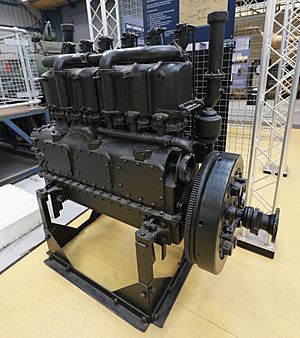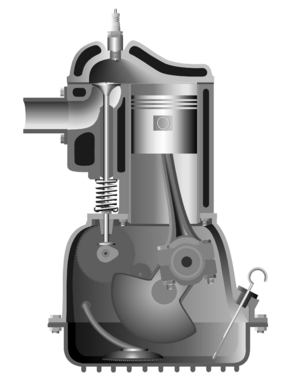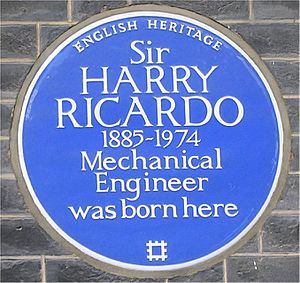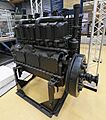Harry Ricardo facts for kids
Quick facts for kids
Harry Ricardo
|
|
|---|---|
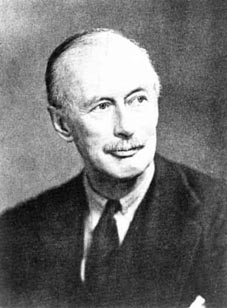 |
|
| Born |
Harry Ralph Ricardo
26 January 1885 |
| Died | 18 May 1974 (aged 89) |
| Nationality | British |
| Education | Rugby School Trinity College, Cambridge |
| Occupation | Engineer |
| Spouse(s) | Beatrice Bertha Hale |
| Children | 3 daughters |
| Parent(s) | Halsey Ralph Ricardo Catherine Jane Ricardo |
| Engineering career | |
| Institutions | Institution of Mechanical Engineers Royal Aircraft Establishment |
| Projects | Mk V tank engine
Citroen Rosalie diesel engine Turbulent Head gasoline combustion system Comet diesel combustion system Rolls-Royce CrecyRolls-Royce Merlin |
| Significant advance | Diesel and Spark Ignition combustion systems Aero engines |
| Awards | Knight Batchelor Fellow of the Royal Society |
Sir Harry Ralph Ricardo (born January 26, 1885 – died May 18, 1974) was a brilliant English engineer. He was one of the most important engine designers and researchers in the early days of the internal combustion engine. These are the types of engines that power cars, planes, and many other machines.
Ricardo made many important improvements to engines. For example, he made the engines used in the first tanks much better. He also led research into how engines burn fuel, which helped create the octane rating system we use for petrol today. He played a big part in developing the sleeve valve engine design. He also invented the "Comet" swirl chamber for diesel engines. This invention made fast diesel engines practical and affordable.
Contents
Early Life and Education
Harry Ricardo was born in London in 1885. He was the oldest of three children. His father, Halsey Ricardo, was an architect. Harry came from a well-off family. He was one of the first people in England to see a car, when his grandfather bought one in 1898.
Harry loved building things from a young age. He had been using tools and building engines since he was ten years old. He went to Rugby School, a famous boarding school. In 1903, he started studying civil engineering at Trinity College, Cambridge University.
Marriage and Family
In 1911, Harry Ricardo married Beatrice Bertha Hale. She was an art student in London. They had three daughters together. They lived most of their married life in Lancing and Edburton in West Sussex.
Early Car Engine Designs
In 1904, during his first year at Cambridge, Ricardo entered a competition. The goal was to design a machine that could travel the furthest on just one litre of petrol. His engine had one cylinder and was quite heavy. However, his motorcycle design won the competition. It traveled about 40 miles on that small amount of fuel.
After this, he was asked to join Professor Bertram Hopkinson. They researched how engines perform. Ricardo finished his studies in 1906. He spent another year at Cambridge doing more engine research.
Before he graduated, Ricardo designed a two-stroke motorcycle engine. He wanted to study how different fuel mixtures affected the burning process inside the engine. A small company, Messrs Lloyd and Plaister, became interested in making his engine. Ricardo designed two sizes, and the smaller one sold about 50 engines. Production stopped in 1914 because of World War I.
In 1909, Ricardo designed a larger two-stroke engine for his cousin, Ralph Ricardo. Ralph had started a small car company called "Two Stroke Engine Company." This engine was used in a car called the Dolphin. The cars were well-made, but they cost more to build than they sold for. The company had more success making two-stroke engines for fishing boats. In 1911, the company closed down. Ricardo continued to design engines for small electric lighting systems until 1914.
Improving Tank Engines
In 1915, Ricardo started a new company called "Engine Patents Ltd." This company developed the engine that would be used in the successful British Mark V tank. The engines used in earlier tanks, like the Mark I, produced a lot of smoke. This smoke easily showed the enemy where the tanks were.
Ricardo was asked to solve this problem. He decided that a completely new engine was needed. The new engine had to fit into the same space as the old one. Ricardo designed it himself. His new six-cylinder engine not only produced less smoke but was also much more powerful. It started at 150 horsepower (hp) and was later improved to 225 hp and even 260 hp.
By April 1917, his company was producing 100 tank engines every week. More than 8,000 of his tank engines were used in the military. These engines were also used in the Mark IX tank and the British version of the Mark VIII. Besides tanks, hundreds of the 150 hp engines were used in France. They provided power and light for workshops, hospitals, and army camps.
Innovations in Aircraft Engines
In 1917, Ricardo's former teacher, Bertram Hopkinson, invited him to join a new engine research facility. This facility later became the RAE. In 1918, Hopkinson died in a plane crash, and Ricardo took over his role. From then on, the department created many experimental engines and research reports. These reports greatly helped the British and world engine industries.
One of Ricardo's first big projects was studying "knocking" or "pinging" in engines. This is when fuel burns unevenly. To study this, he built a special test engine that could change its compression. This research led to the creation of the octane rating system for fuels. It also led to a lot of investment in additives and refining methods to improve octane. Higher-octane fuel used less fuel. This was a key reason why Alcock and Brown could fly across the Atlantic Ocean in their Vickers Vimy bomber, which had Ricardo's engine changes.
Advanced Engine Designs
In 1919, Ricardo studied how fuel burns in both petrol and diesel engines. He realized that making the air inside the combustion chamber turbulent (swirling) made the flame burn faster. He also found that making the chamber as small as possible reduced the distance the flame had to travel. This helped prevent detonation, which is like an uncontrolled explosion.
He later developed the "Comet" design for diesel engines, patented in 1931. This design created a strong swirl of air inside the engine. This made diesel engines run smoothly and efficiently. Many companies bought licenses to use his "Comet" design. It was used in trucks, buses, tractors, cranes, cars, and taxis. The first diesel buses in London in 1931 used a Comet combustion chamber. The 1934 Citroën Rosalie, the world's first mass-produced diesel passenger car, also used a Comet chamber. This meant Britain was a world leader in fast diesel engines for road transport at that time.
In 1922 and 1923, Ricardo published a two-volume book called "The Internal Combustion Engine."
In 1927, Ricardo started Ricardo Consulting Engineers in Shoreham-by-Sea. This company is now known as Ricardo plc. It has become one of the top automotive consulting firms worldwide.
Ricardo also played a big role in the sleeve valve engine. While he didn't invent it, he wrote an important paper in 1927. This paper showed the benefits of the sleeve valve. It suggested that traditional poppet valve engines might not be able to produce much more than 1,500 horsepower. After his paper, several sleeve valve aircraft engines were developed. Companies like Napier, Bristol, and Rolls-Royce used this design for powerful engines like the Bristol Hercules and Napier Sabre.
In 1929, Ricardo was chosen as a Fellow of the Royal Society. This is a very high honor for scientists and engineers.
World War II Contributions
Ricardo's work on the sleeve valve engine helped develop British aircraft engines in the 1930s and during World War II. He also improved the Rolls-Royce Merlin engine used in planes like the De Havilland Mosquito. He added an oxygen system to boost its performance.
Ricardo's research had a global impact. His work helped Britain get better and better fuels in the 1930s. But it also helped Germany develop their own high-octane aviation fuel. This fuel was used in planes like the Focke-Wulf Fw 190, which caused heavy losses for the RAF's Supermarine Spitfires in 1942. Ricardo's research on water injection also helped German engineers. They used it to give their aero-engines a high emergency power boost.
From 1941 to 1945, Ricardo was part of the War Cabinet's engineering advisory committee. He also helped design parts of Sir Frank Whittle's pioneering jet engine.
Later Life and Legacy
In 1944, Ricardo became president of the Institution of Mechanical Engineers. In 1945, he and his wife moved to Graffham in West Sussex. In 1948, Harry Ricardo was knighted. This meant he became "Sir Harry Ricardo" in recognition of his important work in engine engineering.
Ricardo retired from active work at Ricardo Consulting Engineers in 1964. However, he stayed in touch with the engineers there.
In 1974, at 89 years old, Ricardo fell and injured his hip. He passed away six weeks later, on May 18.
On June 16, 2005, a blue plaque was placed outside his birthplace in Bedford Square, London. This plaque honors important historical figures. On July 1, 2010, the Institution of Mechanical Engineers gave Sir Harry Ricardo an Engineering Heritage Award. This award recognized his life and work as one of the most important engineers of the 20th century. The very first internal combustion engine Harry Ricardo designed as a schoolboy is now on display at the Ricardo plc company.
Ricardo plc
In 1915, Ricardo formed Engine Patents Ltd. This company is known today as Ricardo plc. That year, the Royal Naval Air Service asked him to help design a device to move battle tanks onto railway wagons. About 8,000 engines were produced to power these tanks. This made it the UK's first mass-produced internal combustion engine. Many of these engines were also used to power generators in workshops, hospitals, and army camps. The success of this project earned Ricardo £30,000 in royalties. This money allowed him to buy land and set up his company at its current location in 1919.
See also
- British Rail 10100
- Francis Rodwell Banks
- Prosper L'Orange
- Ricardo plc
- Triumph Ricardo
- Triumph slant-four engine
Images for kids


